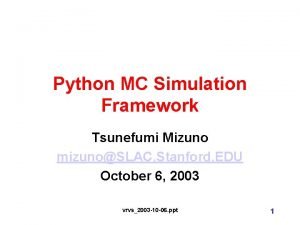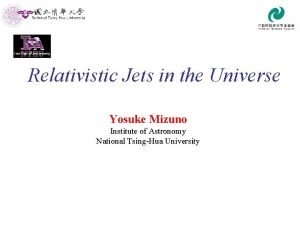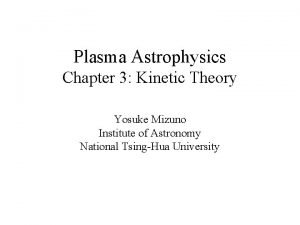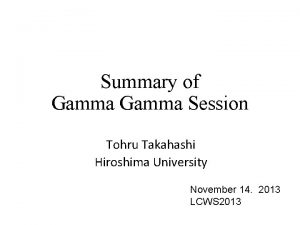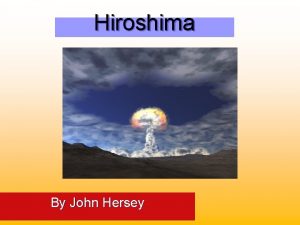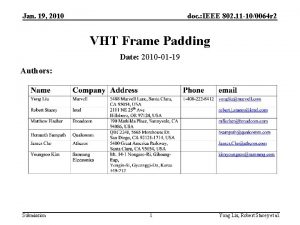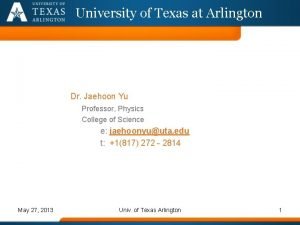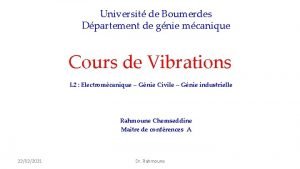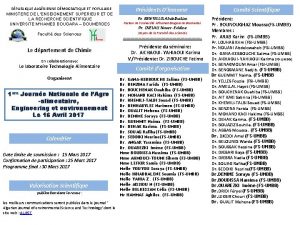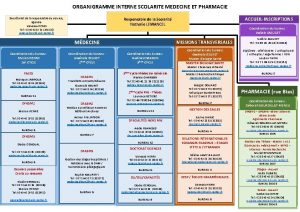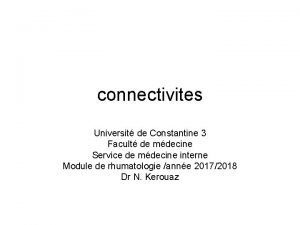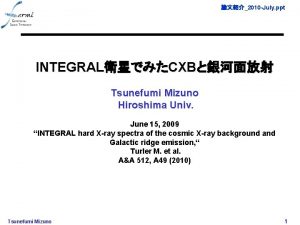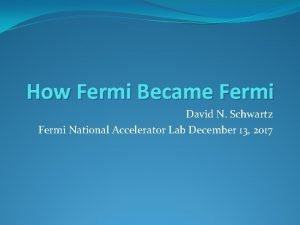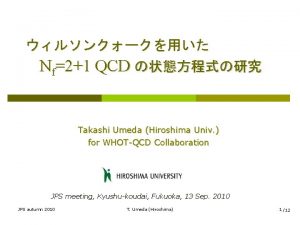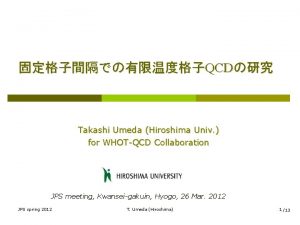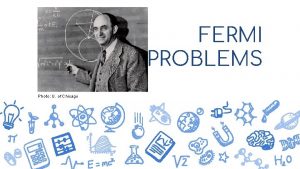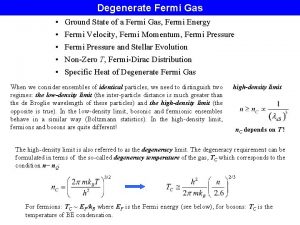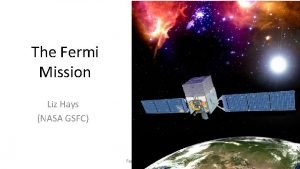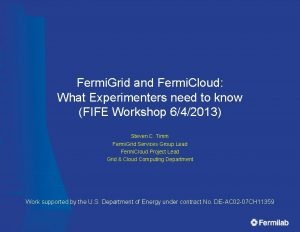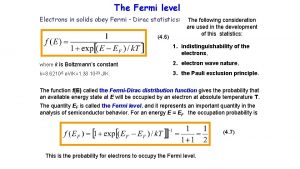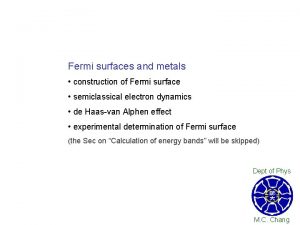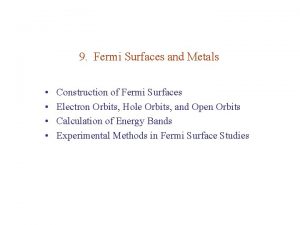2010 Jan ppt Fermi Tsunefumi Mizuno Hiroshima Univ





















- Slides: 21

論文紹介_2010 -Jan. ppt Fermi衛星でみた拡散ガンマ線放射と銀河宇宙線 Tsunefumi Mizuno Hiroshima Univ. June 15, 2009 "Fermi Large Area Telescope Measurements of the Diffuse Gamma-Ray Emission at Intermediate Galactic Latitudes": Abdo, A. A et al. Phys. Rev. Lett. , 103, 251101 (2009) "Fermi observations of Cassiopeia and Cepheus: diffuse gamma-ray emission in the outer Galaxy" Abdo, A. A. et al. ar. Xiv: 0912. 3618 Tsunefumi Mizuno 1

Introduction 論文紹介_2010 -Jan. ppt Cosmic-Rays and Galactic Diffuse Gamma-Rays (1) HE g-rays are produced via interactions between Galactic cosmic-rays (CRs) and the interstellar medium (or interstellar radiation field) (CR accelerator) SNR RX J 1713 -3946 (Interstellar space) X, γ e (Observer) ISM otron r h c syn + - Chandra, Suzaku, Radio telescopes B HESS Pulsar, m-QSO P diffusion He energy losses CNO reacceleration + convection e + etc. π- (GMC is one of the best target matter) gas ISRF gas IC s brems π0 ACTs and Fermi (see K. Hayashi’s talk) Pioneering theoretical works by Hayakawa (1952), Morrison (1958), etc. A powerful probe to study CRs in distant locations Tsunefumi Mizuno 2

Introduction 論文紹介_2010 -Jan. ppt Cosmic-Rays and Galactic Diffuse Gamma-Rays (2) • Prediction of Gamma-rays Ø inverse Compton scattering (photon & CR electron) Ø p 0 -decay (matter & CR nucleon) Ø bremsstrahlung (matter & CR electron) • Ge. V g-rays probes CR protons (and ISM) Tsunefumi Mizuno 3

Introduction 論文紹介_2010 -Jan. ppt Cosmic-Rays and Galactic Diffuse Gamma-Rays (3) • Prediction of Gamma-rays Ø inverse Compton scattering (photon & CR electron) Ø p 0 -decay (matter & CR nucleon) Ø bremsstrahlung (matter & CR electron) • Ge. V g-rays probes CR protons (and ISM) p 0 component has a bump around 1 Ge. V in E 2 spectrum Gp=2 Fermi-LAT (Eg ~ 0. 1 -10 Ge. V) Gp=2. 4 Local Interstellar Spectrum Aharonian 2004 Tsunefumi Mizuno 4

論文紹介_2010 -Jan. ppt Target: Interstellar Medium (Gas) • Gas distribution determined from radio surveys Øvelocity => distance through a rotation curve HI density from LAB survey ØOpacity correction needed especially close to Gal. plane 25° G. C. Clements(1985) (R 0, v 0)=(8. 5 kpc, 220 km/s) http: //www. astro. uni-bonn. de/~webaiub/english/tools_labsurvey. php 30° Dame et al. 2001 0° H 2 density from 2. 6 mm CO line Øassumptions on Xco=N(H 2)/WCO -30° target for producing gamma-rays through p 0 -decay and electron bremsstrahlung Tsunefumi Mizuno 5

Outstanding Question: 論文紹介_2010 -Jan. ppt EGRET Ge. V Excess (1) • We can “measure” the CR spectrum in distant locations by observing diffuse grays. • EGRET observations showed excess emission > 1 Ge. V everywhere in the sky when compared with models based on directly measured CR spectra • Potential explanations Ø Dark Matter Ø Unexpectedly large variations in cosmic-ray spectra over Galaxy Ø Unresolved sources (pulsars, SNRs, …) Ø Instrumental • Fermi-LAT is able to confirm or reject this phenomenon Tsunefumi Mizuno |b|=6°-10° 0. 1 1 10 Ge. V |b|=2°-6° |b|<=2° ~100% difference above 1 Ge. V Hunter et al. 1997 6

Outstanding Question: 論文紹介_2010 -Jan. ppt EGRET Ge. V Excess (2) • We can “measure” the CR spectrum in distant locations by observing diffuse grays. • EGRET observations showed excess emission > 1 Ge. V everywhere in the sky when compared with models based on directly measured CR spectra • Potential explanations Ø Dark Matter Ø Unexpectedly large variations in cosmic-ray spectra over Galaxy Ø Unresolved sources (pulsars, SNRs, …) Orion Region Ø Instrumental • Fermi-LAT is able to confirm or reject this phenomenon Tsunefumi Mizuno (Digel et al. 1999, Aharonian 2001) Data vs. model by E-2. 1 spectrum 7

論文紹介_2010 -Jan. ppt Intermediate Latitude Region seen by LAT (1) |b|=10°-20° EGRET LAT Abdo, A. A et al. Phys. Rev. Lett. , 103, 251101 (2009) 0. 1 1 10 Ge. V • |b|=10°-20°: avoid Galactic Plane, high statistics and high S/N ratio (Extragalactic diffuse) • EGRET spectrum extracted for the same region • LAT spectrum is significantly softer and does not confirm the EGRET Ge. V excess • Tsunefumi Strongly constrains the DM interpretation Mizuno 8

論文紹介_2010 -Jan. ppt Intermediate Latitude Region seen by LAT (2) Abdo, A. A et al. Phys. Rev. Lett. , 103, 251101 (2009) See also Abdo et al. 2009, Ap. J 703, 1249 EGRET LAT p 0 isotropic bremsstrahlung Tsunefumi Mizuno 0. 1 IC 1 10 Ge. V • LAT spectrum is compatible with a prediction based on the LIS • p 0 is the dominant component 9

論文紹介_2010 -Jan. ppt Possible Cause of EGRET/LAT Discrepancy • EGRET also showed significantly harder spectrum for Vela Pulsar (BG negligible). • Could be due to Calibration uncertainty (large correction for backsplash) Tsunefumi Mizuno 10

論文紹介_2010 -Jan. ppt CR Distribution in Galaxy • CR distribution in our Galaxy is a key for understanding their origin and propagation • Distribution of SNRs not well measured • Fermi-LAT is able to map out CR distributions in the Galaxy • LAT data in the 2 nd and 3 rd Galactic quadrant provide us with accurate measurement of CR density distributions in the outer Galaxy Gal. Center Inner Galaxy • Recently accepted article (ar. Xiv: 0912. 3618) discusses the g-rays in the 2 nd quadrant local arm Outer Galaxy • Report on the relevant study in the 3 rd quadrant is in preparation Perseus arm Tsunefumi Mizuno 11

論文紹介_2010 -Jan. ppt Gas Density Distribution • Simple slicing using the rotation curve is not good enough to fully exploit the LAT data • Region boundaries are shifted to the intensity minima • Fit the profile with gaussians and apply spillover correction. Tsunefumi Mizuno 12

論文紹介_2010 -Jan. ppt Data and Analysis Procedure Gamma-ray flux 2 HI maps R=0 -7. 5 kpc, 7. 5 -9. 5 kpc Extra galactic diffuse (uniform) Inverse compton model map (galprop) Excess of E(B-V) map (Grenier et al. 2005) 2 CO maps Gamma-rays are modeled as a linear combination of each component Fit data at each energy bin : “(100~144 Me. V), (144~200 Me. V), … , (9. 05~12. 8 Ge. V)” Gamma-ray spectrum ( ) of each component Tsunefumi Mizuno 13

論文紹介_2010 -Jan. ppt Local HI (CR) Spectrum • Local HI spectrum (Gould Belt) is well represented by the interaction of CRs and ISM • Absolute intensity is ~50% larger than the galprop model Ø CR flux uncertainty, heavy nuclei in CRs and ISM Tsunefumi Mizuno 14

論文紹介_2010 -Jan. ppt Emissivity (CR density Gradient) • Galprop model is based on CR source distribution (traced by pulsars) and conventional CR propagation model (e. g. , CR halo of 4 kpc) • Measured gradient is flatter than the model Ø flatter CR source distribution and/or larger halo than previously thought Ø detailed discussion in forthcoming paper (3 rd quadrant, large-scale diffuse) Tsunefumi Mizuno 15

論文紹介_2010 -Jan. ppt Emissivity Spectrum in Outer Galaxy • HI spectral ratio to that of Gould Belt • Possible spectral hardening is observed (not seen in the 3 rd quadrant) • Systematic uncertainty (unresolved sources, etc. ) not ruled out Local arm to Gould Belt Perseus arm to Gould Belt Tsunefumi Mizuno 16

論文紹介_2010 -Jan. ppt HI vs. CO Emissivities Gould Belt Perseus arm Tsunefumi Mizuno Local arm • HI emissivity vs. CO emissivity of 3 regions • Proportionality supports the idea that CRs penetrate to the core of molecular clouds • Different slope indicate evolution of CO-to-H 2 ratio (see next) 17

Xco Evolution 論文紹介_2010 -Jan. ppt • Moderate evolution ov Xco (=N(H 2)/Wco) is observed • Could be due to the metallicity gradient • Xco in outer Galaxy is much smaller than that inferred by the EGRET study Tsunefumi Mizuno 18

Summary 論文紹介_2010 -Jan. ppt • Diffuse gamma-rays are powerful probe to study CRs and ISM in our Galaxy Ø Useful to constrain the CR protons • EGRET Ge. V excess not confirmed Ø Strongly constrain the DM interpretation Ø Local CRs are compatible with those measured at the Earth • Detailed study of the 2 nd quadrant Ø CRs and ISM in the outer Galaxy Ø Flatter CR gradient than previously assumed Ø Flatter but significant evolution of CO-to-H 2 ratio Ø Relevant studies of the 3 rd quadrant and large-scale analysis in progress Tsunefumi Mizuno 19

論文紹介_2010 -Jan. ppt HI Emissivity Spectra Gould Belt Local arm Perseus arm Tsunefumi Mizuno 20

論文紹介_2010 -Jan. ppt Inter. Stellar Radiation Field • CR e+/e- need targets to create g-rays ØInterstellar radiation field determined from a realistic model taking into account stellar and dust distribution üStarlight (~ 0. 1 mm – 10 mm) üDust (~ 10 mm – 300 mm) ISRF energy density üCMB (>300 mm) R=0 kpc There are uncertainties associated with gas and ISRF R=4 kpc R=8 kpc R=12 kpc Stellar Dust CMB Porter et al. 2008 Tsunefumi Mizuno 21
 Pythonmc
Pythonmc Antecedentes de la calidad
Antecedentes de la calidad Yosuke mizuno
Yosuke mizuno Yosuke mizuno
Yosuke mizuno Human academy japan
Human academy japan Hirodai momiji
Hirodai momiji Tohru hiroshima
Tohru hiroshima Hiroshima the liveliest city in japan
Hiroshima the liveliest city in japan マイクロンメモリジャパン
マイクロンメモリジャパン Hiroshima
Hiroshima Hiroshima
Hiroshima Atomic bomb shadows
Atomic bomb shadows Hiroshima
Hiroshima Jan 19 2010
Jan 19 2010 Uta maverick activity center
Uta maverick activity center Logo université constantine 3
Logo université constantine 3 Http:fsi-st univ-boumerdes-dz
Http:fsi-st univ-boumerdes-dz State univ grant - sug ug
State univ grant - sug ug Fs.umbb
Fs.umbb Certificat de scolarité univ nantes
Certificat de scolarité univ nantes Fs.univ.umbb
Fs.univ.umbb Univ constantine 3
Univ constantine 3
